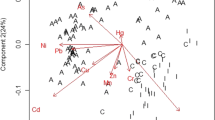Abstract
This study was carried out to evaluate the concentration of trace elements (As, Cd, Cu, Pb, and Zn) in the muscle of carnivorous fish species from three different areas of Todos os Santos Bay (BTS), Bahia State, Brazil. Trace elements were analyzed using inductively coupled plasma-optical emission spectrometry (ICP-OES), and consumption rates advisory for minimizing chronic systemic effects in children and adults were estimated. As concentrations in fish samples from Jiribatuba were higher than legal limits set by FAO, and Cd concentrations in fish from Iguape Bay were high in comparison with FAO and EC. This study provides information about the fish consumption limits, considering the elements concentrations observed in the analyses, in particular As and Cd, necessary for minimizing potential health risks.

Similar content being viewed by others
References
Al-Hossainy, A. F., Mohamed, A. E., Hassan, F. S. M., Allah, M. M. (2012). Determination of cadmium and lead in perch fish samples by differential pulse anodic stripping voltammetry and furnace atomic absorption spectrometry. Arabian Journalof Chemistry, 10, 347–354.
Cirano, M., & Lessa, G. C. (2007). Oceanographic characteristics of Baía de Todos os Santos, Brazil. Revista Brasileira de Geofísica, 25(4), 363–387.
Dsikowitzky, L., Mengesha, M., Dadebo, E., Carvalho, C. E. V., & Sindern, S. (2013). Assessment of heavy metals in water samples and tissues of edible fish species from Awassa and Koka Rift Valley Lakes, Ethiopia. Environmental Monitoring and Assessment, 185, 3117–3131.
Dural, M., Göksu, M. Z. L., & Özak, A. A. (2007). Investigation of heavy metal levels in economically important fish species captured from the Tuzla lagoon. Food Chemistry, 102, 415–421.
EC (European Commission), (2006). Commission Regulation (EC) No 1881/2006 of the European parliament and the council of 19 December 2006 setting maximum levelsfor certain contaminants in foodstuffs. Off. J. Eur. Communities L364 (18).
FAO (Food Administration Organization). (1983). Compilation of legal limits for hazardous substances in fish and fishery products. FAO fish. Circ. 764 (p. 102). Rome: FAO.
Hassaninezhad, L., Safahieh, A., Salamat, N., Savari, A., & Majd, N. E. (2014). Assessment of gill pathological responses in the tropical fish yellowfin seabream of Persian Gulf under mercury exposure. Toxicology Reports, 1, 621–628.
Hatje, V., Andrade, J. B., (2009). Introdução. In: Hatje, Vanessa and Andrade, Jailson B. Baía de Todos os Santos: Aspectos Oceanográficos. p. 19–23. Edufba.
Hatje, V., Bícego, M. C., Carvalho, G. C., Andrade, J. B., (2009). Contaminação Química. In: Hatje, Vanessa and Andrade, Jailson B. Baía de Todos os Santos: Aspectos Oceanográficos. p. 247–297. Edufba.
Hatje, V., Macedo, S. M., De Jesus, R. M., Cotrim, G., Garcia, K. S., De Queiroz, A. F., & Ferreira, S. L. C. (2010). Inorganic As speciation and bioavailability in estuarine sediments of Todos os Santos Bay, BA, Brazil. Marine Pollution Bulletin, 60, 2225–2232.
Kasper, D., Botaro, D., Palermo, E. F. A., & Malm, O. (2007). Mercúrio em peixes- Fontes e Contaminação. Oecol. Bras., 11(2), 228–239.
Kitahara, S. E., Okada, I. A., Sakuma, A. M., Zenebon, O., Jesus, R. S., & Tenuta Filho, A. (2000). Mercúrio total em pescado de água-doce. Ciência e Tecnologia de Alimentos, 20, 267–273.
Lessa, G. C., Cirano, M., Genz, F., Tanajura, C. A. S., Silva, R. R., (2009). Oceanografia Física. In Hatje, Vanessa and Andrade, Jailson B. Baía de Todos os Santos: Aspectos Oceanográficos. p. 71–119. Edufba.
Queiroz, A. F. S., & Celino, J. J. (2008). Manguezais e ecossistemas estuarinos da Baía de Todos os Santos. In A. F. S. Queiroz & J. J. Celino (Eds.), Avaliação de ambientes na Baía deTodos os Santos: aspectos geoquímicos, geofísicos e biológicos (pp. 39–58). Salvador: UFBA.
Rocha, G. O., Guarieiro, A. L. N., De Andrade, J. B., Eça, G. F., De Aragão, N. M., Aguiar, R. M., Korn, M. G. A., Brito, G. B., Moura, C. W. N., & Hatje, V. (2012). Contaminação na Baía de Todos os Santos. Rev. Virtual Quim., 4(5), 583–610.
Souza, M. M., Windmöller, C. C., & Hatje, V. (2011). Shellfish from Todos os Santos Bay, Bahia, Brazil: treat or threat? Marine Pollution Bulletin, 62, 2254–2263.
Souza, M. F. L., Longhini, C. M., Silva, A. M., & Lentini, C. A. D. (2012). Ciclo do Carbono: Processos Biogeoquímicos, Físicos e Interações entre Compartimentos na Baía de Todos os Santos. Rev. Virtual Quim., 4(5), 566–582.
Teles, L. T., Zara, L. F., Furlanetto, U. L. R., & Silva, N. J. (2008). Elementos traço em peixes de interesse comercial do Rio Caiapó (Goiás, Brasil) em área sob impacto ambiental. Estudos, 35(11), 1055–1067.
Tinggi, U., Reilly, C., Hahn, S., & Capra, M. J. (1992). Comparison of wet digestion procedures for the determination of cadmium and lead in marine biological tissues by Zeeman graphite furnace atomic absorption spectrophotometry. The Science of the Total Environment, 125, 15–23.
Tonnelier, A., Coecke, S., & Zaldívar, J. (2012). Screening of chemicals for human bioaccumulative potential with a physiologically based toxicokinetic model. Archives of Toxicology, 86, 393–403.
USEPA (US Environmental Protection Agency). (2000). Guidance for assessing chemical contamination data for use in fish advisories. Vol. II. Washington: Risk Assessment and Fish Consumption Limits EPA/823-B94-004United States Environmental Protection Agency.
USEPA (US Environmental Protection Agency), (2015). Human health risk assessment. Regional Screening Level (RSL)—Summary Table.
Vardanyan, Z., & Trchounian, A. (2015). Cu(II), Fe(III) and Mn(II) combinations as environmental stress factors have distinguishing effects on Enterococcus hirae. Journal of Environmental Sciences, 28, 95–100.
WHO (1995). CODEX general standard for contaminants and toxins in food and feed.
Acknowledgements
The authors would like to thank the professionals of the Laboratory of Petroleum Studies (LEPETRO-UFBA) and the Research Support Agency of Bahia State (FAPESB).
Author information
Authors and Affiliations
Corresponding author
Rights and permissions
About this article
Cite this article
de Santana, C.O., de Jesus, T.B., de Aguiar, W.M. et al. Assessment of health risk related to the ingestion of trace metals through fish consumption in Todos os Santos Bay. Environ Monit Assess 189, 204 (2017). https://doi.org/10.1007/s10661-017-5913-7
Received:
Accepted:
Published:
DOI: https://doi.org/10.1007/s10661-017-5913-7




